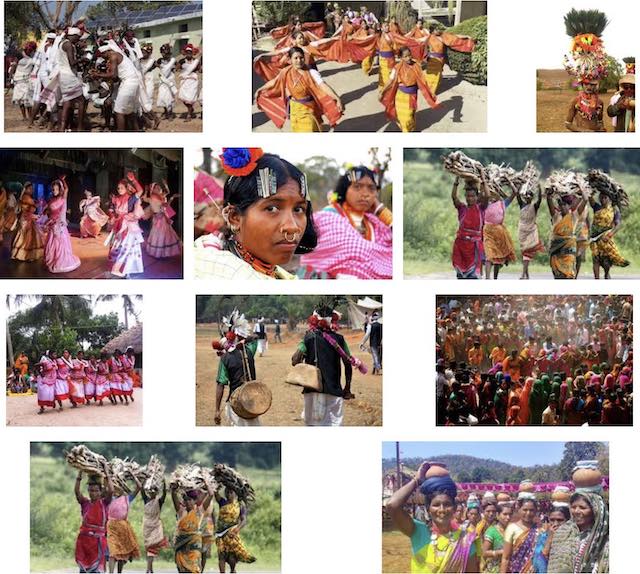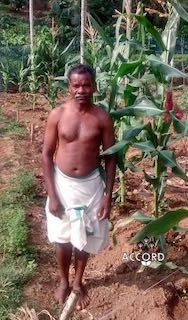According to the Census of 2011, the ST population in India was 104.5 million, accounting for 8.63 percent of the total population of the country. | Learn more >>
Source: Foreword by Dr. S. Parasuraman in “Tribal Sub-Plan in Maharashtra: A Diagnostic Study” (TATA Institute of Social Sciences, Mumbai supported by Unicef Maharashtra, December 2015)
URL: https://cdnbbsr.s3waas.gov.in
Date Visited: 5 July 2021
Total population of Scheduled Tribes is 84,326,240 as per the Census 2001 which accounts for 8.2% of the total population of country. Majority of the Scheduled tribe population live in rural areas and their population is 10.4 % of the total rural population of the country. […]
Table 5: Proportion of SC/ST population (%) […]
The share of the Scheduled Tribe population in urban areas is a meager 2.4%. Madhya Pradesh, Maharastra, Orissa, Gujrat, Rajsthan, Jharkhand, Chhatishgarh, Andhra Pradesh, West Bengal, and Karnataka are the State having larger number of Scheduled Tribes These states account for 83.2% of the total Scheduled Tribe population of the country. Assam, Meghalaya, Nagaland, Jammu & Kashmir, Tripura, Mizoram, Bihar, Manipur, Arunachal Pradesh, and Tamil Nadu, account for another 15.3% of the total Scheduled Tribe population. The share of the remaining states / Uts is negligible.
Lakshdweep, Mizoram, Nagaland, Meghalaya, Arunachal Pradesh, Dadra & Nagar Haveli, are predominantly tribal States /Union territories where Scheduled Tribes population constitutes more than 60% of their total population. No Scheduled Tribes is notified in Punjab, Chandigarh, Haryana, Delhi, and Pondicherry.
At the village level out of the total 5.94 lakh villages in the country 1.53 lakh or 1\4 of the villages, do not have any Scheduled Caste population. In 171,865 villages and 2,931 UAs / Towns, the proportion of the Scheduled Caste population is less than 20 % while in more than 20% while in 154,481 villages and 856 UAs/Towns it is more than 20% but less than 50%.
On the other hand, there are 105,295 villages and 57 UAs/Towns which have more than 50% Scheduled tribes population in the country while 3.23 lakh or half of the villages do not have any Scheduled Tribes population. It is due the fact that, while the Scheduled Castes population is more widely spread over both in rural and urban areas, the scheduled tribe population prefers to live in groups in the rural surroundings.
Source: Census And You [2001 figures]
https://censusindia.gov.in/Census_And_You/scheduled_castes_and_sceduled_tribes.aspx
Date Visited: 4 September 2021
For how long will I have to
Bear the pain of development
Or is it that I will be done to death
Before attaining development?
Ram Dayal Munda in “The Pain of Development” (Vikas Ka Dard) courtesy Dr. Ivy Hansdak >>
We urbanise, we celebrate; but is urbanisation providing basic livelihood?
Census 2021 preparations are underway for more than a year now. One of the first tasks the Office of the Registrar General and Census Commissioner, India was to identify the country’s urban and rural areas. For this, officials created a base map by applying the census criteria.
Officials involved in this process say it is surprising how quickly urbanisation is spreading, and that rural India will be history sooner than we think. Many of the urban areas identified in Census 2011 have expanded while thousands of villages have turned into towns, as per the census definition, the officials say. […]
What are the implications of this change? It’s perilous, because with India’s transition from a predominantly rural economy to an urban one, people’s occupations and preferences will also change.
The immediate concern is whether India’s farming population will remain the same or will it migrate to non-farm occupations. The other big questions are who would be left in the farming sector and whether agriculture would survive by being lucrative enough to provide for the survival of its practitioners? […]
Between Census 2001 and Census 2011, the number of Census Towns increased from 1,362 to 3,894. This indicates that people in rural areas are quitting farming or joining non-farm livelihoods. Millions of farmers have quit agriculture and, worryingly, very few from the current generation are entering the sector.
In absolute terms, India is losing farmers. […]
This leaves us with that big conundrum: We urbanise and celebrate it as a sure shot path to prosperity, but urbanisation doesn’t provide basic livelihood to people who have migrated from rural areas. This explains the current slump in demand that is keeping the overall economy down.
Source: “Census 2021: India’s Urban-rural conundrum” by Richard Mahapatra, Down to Earth 28 October 2019
URL: https://www.downtoearth.org.in/blog/urbanisation/census-2021-india-s-urban-rural-conundrum-67221
Date Visited: 16 July 2022
Please note: “India’s population forecast provided in the United Nations Population Fund (UNFPA) State of World Population report [2023] is an estimate since there has been no census in the country since 2011. After 140 years of uninterrupted census every 10 years, the 2021 census was cancelled because of Covid and postponed to 2022. Now it has been pushed back again to 2024.” – BBC News Delhi (19 April 2023) https://www.bbc.co.uk/news/world-asia-india-65320690 >>
The World Inequality Report 2022 has shed light on starkly growing inequalities in India. But, under the present regime, there has been a subversion of discourse required to address these yawning material and social chasms. […]
India’s worrying ranking in the Global Hunger Index: 101 out 116 (and behind Bangladesh, Nepal and Pakistan).
Nissim Mannathukkaren (Dalhousie University) in “How Hindu Nationalism Enables India’s Slide Into Inequality” (The Wire, 28 December 2021)
https://m.thewire.in/article/communalism/how-hindu-nationalism-enabled-indias-slide-into-inequality
Date Visited: 16 July 2022
See also
Adverse inclusion | Casteism | Rural poverty
Childhood | Tribal Children’s Right to Education in India
Demographic Status of Scheduled Tribe Population of India (Census figures 2011)
Fact checking | Figures, census and other statistics
Human Rights Commission (posts) | www.nhrc.nic.in (Government of India)
Search tips | Names of tribal communities, regions and states of India
“What is the Forest Rights Act about?” – Campaign for Survival and Dignity
“Who are Scheduled Tribes?” – Government of India (National Commission for Scheduled Tribes, NCST)
Find publications by reputed authors (add “open access” for freely downloadable content)
Up-to-date reports by Indian experts and journalists
Search tips
Combine the name of any particular state, language or region with that of any tribal (Adivasi) community.
Add keywords of special interest (music, poetry, dance just as health, sacred grove and biodiversity); learn about the rights of Scheduled Tribes such as the “Forest Rights Act” (FRA); and the United Nations “Declaration on the Rights of Indigenous Peoples”, “Universal Declaration of Human Rights”, “women’s rights”, or “children’s right to education”.
Ask a question that includes “tribal” or “Adivasi”, for instance: “Adivasi way of life better?” (or “tribal way of life worse?”)
Specify any particular issue or news item (biodiversity, bonded labour and human trafficking, climate change, ecology, economic development, ethnobotany, ethnomedicine, global warming, hunter-gatherers in a particular region or state, prevention of rural poverty, water access).
For official figures include “scheduled tribe ST” along with a union state or region: e.g. “Chhattisgarh ST community”, “Himalayan tribe”, “Scheduled tribe Tamil Nadu census”, “ST Kerala census”, “Particularly Vulnerable Tribal Group Jharkhand”, “PVTG Rajasthan”, “Adivasi ST Kerala”, “Adibasi ST West Bengal” etc.
In case the Google Custom Search window is not displayed here try the following: (1) toggle between “Reader” and regular viewing; (2) in your browser’s Security settings select “Enable JavaScript” | More tips >>
Note: hyperlinks and quotes are meant for fact-checking and information purposes only | Disclaimer >>
List of websites covered by this Google custom search engine
Academia.edu (platform for academics to share research papers) – www.academia.edu
Archive.org – https://archive.org
Centre for Science and Environment – https://www.cseindia.org
Current Conservation – https://www.currentconservation.org
Development and Cooperation (D+C) https://www.dandc.eu
Down To Earth (India) – www.downtoearth.org.in
India Environment Portal – www.indiaenvironmentportal.org.in
Harnessing Nature Magazine – https://harnessingnature.online
Mongabay-India – https://india.mongabay.com
M S Swaminathan Research Foundation – www.mssrf.org
Navdanya (protecting India’s biodiversity based food heritage) – https://navdanya.org
Third World Network (Penang, Malaysia) – https://twn.my
The Shola Trust (nature conservation in the Nilgiri region) – www.thesholatrust.org

Indian online periodicals and platforms | Images view >>
~ ~ ~
Personalize your CustomSearch by combining other search words >>
(e.g. name of a tribal community and region, a craft, or dance and puppetry)
Research the above issues with the help of Shodhganga: A reservoir of theses from universities all over India, made available under Open Access >>
Note: hyperlinks and quotes are meant for fact-checking and information purposes only | Disclaimer >>
